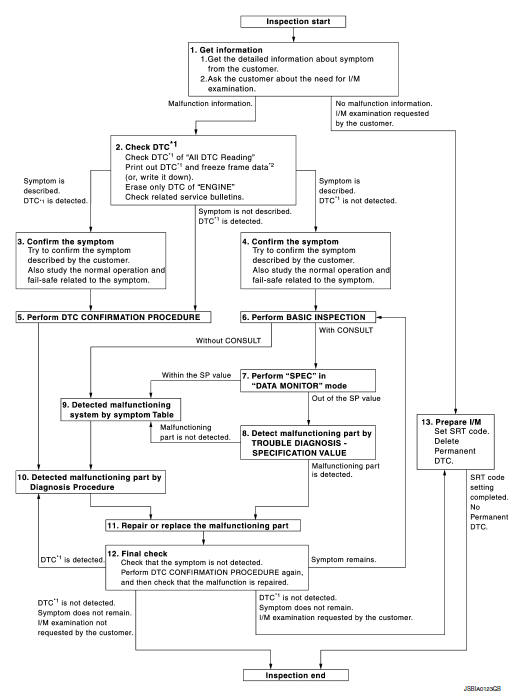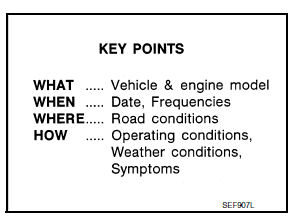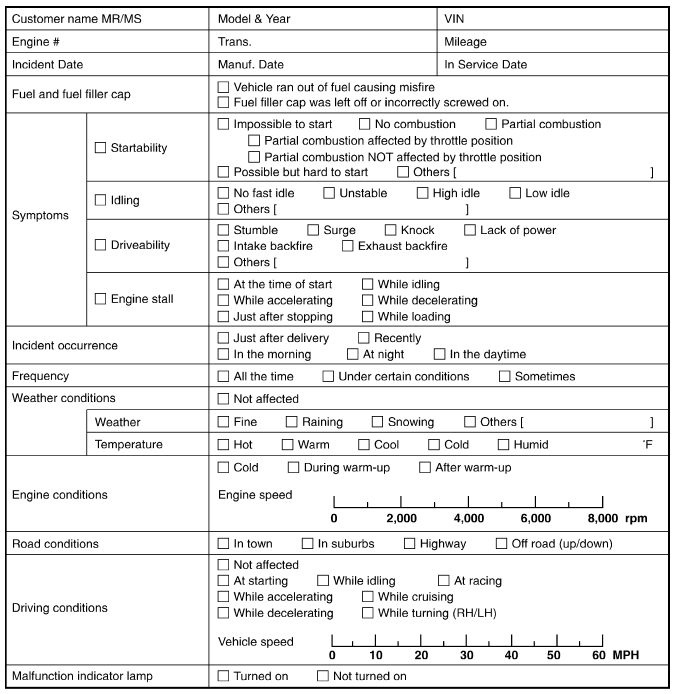Nissan Sentra Service Manual: Diagnosis and repair workflow
Work Flow
OVERALL SEQUENCE

*1: Include 1st trip DTC.
*2: Include 1st trip freeze frame data.
DETAILED FLOW
1.GET INFORMATION FOR SYMPTOM
Get the detailed information from the customer about the symptom (the condition and the environment when the incident/malfunction occurred) using the “Diagnostic Work Sheet”. (Refer to EC-129, "Diagnostic Work Sheet".)
>> GO TO 2.
2.CHECK DTC
- Check DTC.
- Perform the following procedure if DTC is displayed.
- Record DTC and freeze frame data. (Print them out using CONSULT or GST.)
- Erase DTC.
 With CONSULT: “How to Erase DTC
With CONSULT: “How to Erase DTC
and 1st Trip DTC” in EC-66, "CONSULT Function".
 Without CONSULT: “How to Erase
Without CONSULT: “How to Erase
Self-diagnostic Results” in EC-63, "On Board Diagnosis Function".
- Study the relationship between the cause detected by DTC and the symptom
described by the customer.
(Symptom Table is useful. Refer to EC-473, "Symptom Table".)
- Check related service bulletins for information.
Is any symptom described and is any DTC detected?
Symptom is described, DTC is detected>>GO TO 3.
Symptom is described, DTC is not detected>>GO TO 4.
Symptom is not described, DTC is detected>>GO TO 5.
3.CONFIRM THE SYMPTOM
Try to confirm the symptom described by the customer (except MIL ON).
Also study the normal operation and fail safe related to the symptom. Refer to EC-478, "Description" and EC- 90, "Fail Safe".
Diagnosis Work Sheet is useful to verify the incident.
Verify relation between the symptom and the condition when the symptom is detected.
>> GO TO 5.
4.CONFIRM THE SYMPTOM
Try to confirm the symptom described by the customer.
Also study the normal operation and fail safe related to the symptom. Refer to EC-478, "Description" and EC- 90, "Fail Safe".
Diagnosis Work Sheet is useful to verify the incident.
Verify relation between the symptom and the condition when the symptom is detected.
>> GO TO 6.
5.PERFORM DTC CONFIRMATION PROCEDURE
Perform DTC CONFIRMATION PROCEDURE for the displayed DTC, and then make sure that DTC is detected again.
If two or more DTCs are detected, refer to EC-93, "DTC Inspection Priority Chart" and determine trouble diagnosis order.
NOTE:
- Freeze frame data is useful if the DTC is not detected.
- Perform Component Function Check if DTC CONFIRMATION PROCEDURE is not
included on Service
Manual. This simplified check procedure is an effective alternative though
DTC cannot be detected during
this check.
If the result of Component Function Check is NG, it is the same as the detection of DTC by DTC CONFIRMATION PROCEDURE.
Is DTC detected?
YES >> GO TO 10.
NO >> Check according to EC-94, "DTC Index".
6.PERFORM BASIC INSPECTION
Perform EC-131, "Work Procedure".
Do you have CONSULT? YES >> GO TO 7.
NO >> GO TO 9.
7.PERFORM SPEC IN DATA MONITOR MODE
 With CONSULT
With CONSULT
Make sure that “MAS A/F SE-B1”, “B/FUEL SCHDL” and “A/F ALPHA-B1” are within the SP value using CONSULT in “SPEC” of “DATA MONITOR” mode. Refer to EC-157, "Component Function Check".
Is the measurement value within the SP value? YES >> GO TO 9.
NO >> GO TO 8.
8.DETECT MALFUNCTIONING PART BY TROUBLE DIAGNOSIS - SPECIFICATION VALUE
Detect malfunctioning part according to EC-158, "Diagnosis Procedure".
Is malfunctioning part detected? YES >> GO TO 11.
NO >> GO TO 9.
9.DETECT MALFUNCTIONING SYSTEM BY SYMPTOM TABLE
Detect malfunctioning system according to EC-473, "Symptom Table" based on the confirmed symptom in step 4, and determine the trouble diagnosis order based on possible causes and symptom.
>> GO TO 10.
10.DETECT MALFUNCTIONING PART BY DIAGNOSIS PROCEDURE
Inspect according to Diagnosis Procedure of the system.
NOTE:
The Diagnosis Procedure in EC section described based on open circuit inspection. A short circuit inspection is also required for the circuit check in the Diagnosis Procedure. For details, refer to Circuit Inspection in GI- 42, "Circuit Inspection".
Is malfunctioning part detected? YES >> GO TO 11.
NO >> Monitor input data from related sensors or check the voltage of related ECM terminals using CONSULT.
Refer to EC-77, "Reference Value".
11.REPAIR OR REPLACE THE MALFUNCTIONING PART
- Repair or replace the malfunctioning part.
- Reconnect parts or connectors disconnected during Diagnosis Procedure again after repair and replacement.
- Check DTC. If DTC is displayed, erase it. Refer to the following.
 With CONSULT: “How to Erase DTC
With CONSULT: “How to Erase DTC
and 1st Trip DTC” in EC-66, "CONSULT Function".
 Without CONSULT: “How to Erase
Without CONSULT: “How to Erase
Self-diagnostic Results” in EC-63, "On Board Diagnosis Function".
>> GO TO 12.
12.FINAL CHECK
When DTC was detected in step 2, perform DTC CONFIRMATION PROCEDURE or Component Function Check again, and then check that the malfunction have been completely repaired.
When symptom was described from the customer, refer to confirmed symptom in step 3 or 4, and check that the symptom is not detected.
Is DTC detected and does symptom remain? YES-1 >> DTC is detected: GO TO 10.
YES-2 >> Symptom remains: GO TO 6.
NO-1 >> No request for I/M examination from the customer: Before returning the
vehicle to the customer,
always erase unnecessary DTC in ECM and TCM (
 With CONSULT: Refer to “How to
With CONSULT: Refer to “How to
Erase
DTC and 1st Trip DTC” in EC-66, "CONSULT Function",
 Without CONSULT: Refer to “How to
Without CONSULT: Refer to “How to
Erase Self-diagnostic Results” in EC-63, "On Board Diagnosis Function"). If the
completion of
SRT is needed, drive vehicle under the specific driving pattern. Refer to
EC-146, "SRT Set Driving
Pattern".
NO-2 >> I/M examination, requested from the customer: GO TO 13.
13.PREPARE FOR I/M EXAMINATION
- Set SRT codes. Refer to EC-145, "Description".
- Erase permanent DTCs. Refer to EC-151, "Description".
>> INSPECTION END
Diagnostic Work Sheet
DESCRIPTION
There are many operating conditions that lead to the malfunction of engine components. A good grasp of such conditions can make troubleshooting faster and more accurate.
In general, each customer feels differently about a incident. It is important to fully understand the symptoms or conditions for a customer complaint.
Utilize a diagnostic worksheet like the one on the next page in order to organize all the information for troubleshooting.
Some conditions may cause the MIL to come on steady or blink and DTC to be detected. Examples: Vehicle ran out of fuel, which caused the engine to misfire.

Worksheet sample

 Basic inspection
Basic inspection
...
 Basic inspection
Basic inspection
Work Procedure
1.INSPECTION START
Check service records for any recent repairs that may indicate a related
malfunction, or a current need for
scheduled maintenance.
Open engine hood and ch ...
Other materials:
CVT Fluid filter
Exploded View
Transaxle assembly
CVT fluid filter
Fluid filter cover
CVT fluid
Removal and Installation
REMOVAL
Remove neighboring parts of CVT fluid filter.
Remove fluid filter cover mounting bolt (A).
Remove fluid filter cover (1) from transaxle by rotating leftw ...
P0116 ECT Sensor
DTC Logic
DTC DETECTION LOGIC
DTC No.
CONSULT screen terms
(Trouble diagnosis content)
DTC detecting condition
Possible cause
P0116
ECT SEN/CIRC
(Engine coolant temperature
sensor 1 circuit range/performance)
The comparison result of signals transmitted
t ...
F.M.V.S.S./C.M.V.S.S. certification label
The Federal/Canadian Motor Vehicle Safety
Standard (F.M.V.S.S./C.M.V.S.S.) certification label
is affixed as shown. This label contains valuable
vehicle information, such as: Gross Vehicle
Weight Ratings (GVWR), Gross Axle Weight
Rating (GAWR), month and year of manufacture,
Vehicle Identi ...
